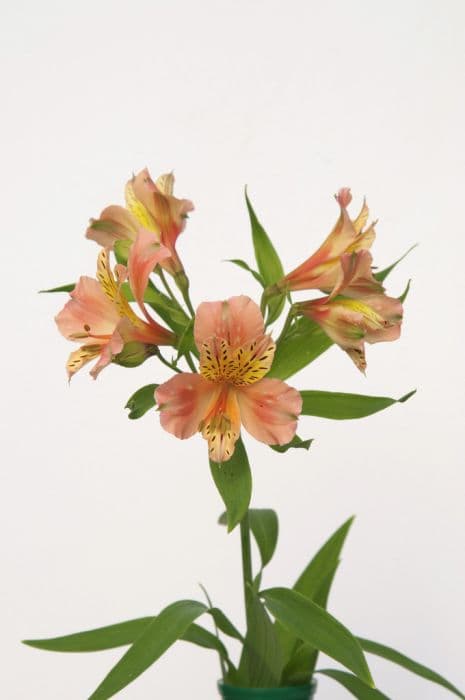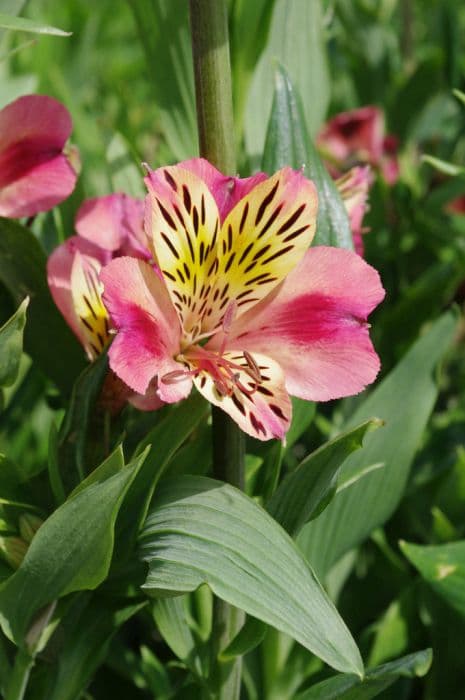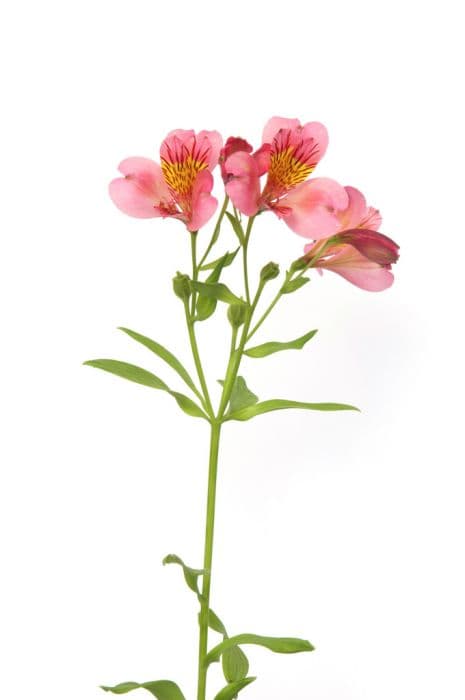Peruvian lily 'Orange Gem' Alstroemeria 'Orange Gem'

ABOUT
'Orange Gem' is a tall herbaceous perennial to 1.2m, with terminal umbels of light orange flowers tipped with red-brown, the inner segments with a violet-red flare and edged with yellow
About this plant
 Names
NamesSynonyms
Peruvian Lily, Lily of the Incas, Parrot Lily, Alstroemeria.
Common names
Alstroemeria 'Orange Gem'.
 Characteristics
CharacteristicsLife cycle
Perennials
Foliage type
Deciduous
Color of leaves
Green
Flower color
Orange
Height
2-3 feet (60-90 cm)
Spread
1-2 feet (30-60 cm)
Plant type
Herb
Hardiness zones
7
Native area
South America
Benefits
 General Benefits
General Benefits- Extended blooming season: Alstroemeria 'Orange Gem', commonly known as Peruvian Lily, typically has a long flowering period lasting several months.
- Vibrant colors: This variety boasts striking orange flowers that can add a splash of color to gardens and floral arrangements.
- Attracts pollinators: Peruvian Lilies can attract bees, butterflies, and other pollinating insects to your garden, helping to promote biodiversity.
- Drought-resistant: Once established, Alstroemeria 'Orange Gem' can tolerate periods of low water, making it suitable for xeriscaping or drought-prone areas.
- Easy to care for: Peruvian Lilies are relatively low maintenance, requiring minimal care once they are settled in an appropriate location.
- Cut flower potential: The blossoms of Alstroemeria 'Orange Gem' have a long vase life, which makes them excellent for use in cut flower arrangements.
- Garden versatility: These plants can be grown in beds, borders, and containers, offering flexibility in garden design and space usage.
- Rapid growth: Peruvian Lilies can grow quickly and fill in garden spaces, providing a lush look relatively fast.
 Medical Properties
Medical PropertiesThis plant is not used for medical purposes.
 Air-purifying Qualities
Air-purifying QualitiesThis plant is not specifically known for air purifying qualities.
 Other Uses
Other Uses- Floral Art and Design: Alstroemeria 'Orange Gem', often known as Peruvian lily, is commonly used in floral art for its vibrant colors and unique patterns which can add an exotic touch to any arrangement.
- Photography Subjects: The bright and detailed blossoms of the Peruvian lily make them excellent subjects for photographers looking to capture the intricate beauty of flowers.
- Garden Borders: Their compact growth habit and long blooming period make Peruvian lilies suitable for creating vivid borders in home gardens.
- Educational Tool: The unique reproductive mechanisms of Peruvian lilies, involving complex pollination strategies, can serve as an educational tool for botany students.
- Color Dye: The pigments in Peruvian lily petals could potentially be used as a natural color dye for fabrics or crafts.
- Craft Projects: Dried Peruvian lily flowers can be used in scrapbooking, card making, or as embellishments in other craft projects.
- Culinary Decoration: Though not widely practiced, the petals of Peruvian lily, if confirmed non-toxic, may serve as a decorative element for plating in high-end culinary dishes.
- Companion Planting: Peruvian lilies can be planted alongside vegetables and herbs to create a diverse ecosystem that may deter pests or attract beneficial insects.
- Event Theming: The vibrant orange blossoms can be used to theme events and parties, providing a consistent color scheme throughout the decor.
- Scented Sachets: Dried Peruvian lily flowers can retain their fragrance for a while and be used in potpourri or scented sachets to freshen up drawers and closets.
Interesting Facts
 Feng Shui
Feng ShuiThe Peruvian Lily is not used in Feng Shui practice.
 Zodiac Sign Compitability
Zodiac Sign CompitabilityThe Peruvian Lily is not used in astrology practice.
 Plant Symbolism
Plant Symbolism- Friendship: The Alstroemeria, also known as the Peruvian Lily or Lily of the Incas, often represents lasting bonds between friends, reflecting the long-lasting nature of the plant.
- Devotion: It's a common symbol for expressing a steadfast commitment to another, whether in friendship, love, or support.
- Wealth and Prosperity: The bright and abundant blossoms of the Peruvian Lily can signify material wealth and a prosperous life.
- Achievement: The flower’s complex structure can represent the ability to achieve complex goals or multitask effectively.
- Mutual Support: Given as a gift, Peruvian Lilies suggest mutual support in all endeavors.
 Water
WaterPeruvian lilies, including 'Orange Gem', should be watered deeply and then allowed to dry out slightly before watering again. This typically means watering once a week, but this may vary based on climate and weather conditions. During the growing season, deliver about 1 inch of water per week, which equates to approximately 0.6 gallons for a standard-sized plant. In the hottest parts of summer, you may need to water more frequently to maintain consistent moisture, but always check the soil moisture first to prevent overwatering.
 Light
LightPeruvian lilies thrive in full sun to partial shade conditions. For the best growth and flower production, 'Orange Gem' should receive 6 to 8 hours of direct sunlight daily. A spot that gets morning sunlight but is shielded from the intense afternoon sun is ideal, ensuring the plant receives sufficient light without being exposed to potential scorching.
 Temperature
TemperaturePeruvian lilies prefer temperate climates and 'Orange Gem' thrives in temperatures between 65 and 80 degrees Fahrenheit. They can withstand minimum temperatures down to about 25 degrees Fahrenheit, but frost and freezing conditions can damage the plant. It's best to plant 'Orange Gem' in an area that generally stays within this temperature range throughout the growing season.
 Pruning
PruningPruning Peruvian lilies is important to stimulate growth and maintain plant health. For 'Orange Gem', pruning should be done to remove faded or dead flowers and to trim back any damaged or diseased stems. This is typically done after a flowering cycle or as needed throughout the growing season. The best time to heavily prune 'Orange Gem' is in late winter or early spring before new growth begins.
 Cleaning
CleaningAs needed
 Soil
SoilThe Peruvian Lily, or Alstroemeria 'Orange Gem', thrives in rich, well-draining soil with a pH ranging from slightly acidic to neutral (pH 6.0 to 7.0). For best results, mix two parts loam, one part peat, and one part sand or perlite to ensure good drainage and fertility.
 Repotting
RepottingPeruvian Lilies should be repotted every two to three years. When roots become crowded, repot in spring before the growing season starts.
 Humidity & Misting
Humidity & MistingPeruvian Lily prefers moderate humidity levels. Keeping the humidity around 40-50% is typically conducive to their growth.
 Suitable locations
Suitable locationsIndoor
Place in bright, indirect light and ensure well-draining soil.
Outdoor
Plant in partial shade and protect from strong winds.
Hardiness zone
7-10 USDA
 Life cycle
Life cycleThe Peruvian Lily 'Orange Gem' begins its life as a rhizomatous tuber, which, when planted in early spring after the last frost, will sprout into shoots. Seedlings emerge and develop into a clump of lance-shaped foliage, during which the plant establishes a strong root system. As the plant matures, it produces sturdy, upright stems that bear clusters of striking orange flowers with distinctive flecks and streaks, typically blooming in late spring through summer. After the flowering period, the plant enters a dormancy phase in the winter, especially in cooler climates, where it may die back to the ground. However, in milder climates or with proper mulching, the foliage may persist year-round. Unfertilized flowers will fade, and seeds may form, but propagation is commonly done by dividing the tubers every few years in the spring, thus continuing the cycle.
 Propogation
PropogationPropogation time
Spring-Early Summer
The most popular method of propagation for the Alstroemeria 'Orange Gem', also known as Peruvian Lily, is by division. This process is ideally done in the spring, just before the growing season begins when the plant is not in active growth. You should carefully unearth the clumps of tubers and gently separate them by hand, ensuring that each division has at least one or two shoots attached. You can then replant the divisions immediately at the same depth they were growing at previously, spacing them about 12 to 24 inches apart (30 to 60 cm). Water adequately after planting to encourage good root establishment. It's important not to damage the tubers during division as they can be quite brittle.




![Peruvian lily [H.R.H. Princess Alice]](/_next/image?url=https%3A%2F%2Fplants-admin.emdemapps.com%2Fimages%2Fplants%2F%2Fimages%2F604b55e81c8b0.png&w=640&q=75)
![Peruvian lily [Indian summer]](/_next/image?url=https%3A%2F%2Fplants-admin.emdemapps.com%2Fimages%2Fplants%2F%2Fimages%2F604b616bc746b.png&w=640&q=75)
![Peruvian lily [Inticancha Creamy Dark Pink]](/_next/image?url=https%3A%2F%2Fplants-admin.emdemapps.com%2Fimages%2Fplants%2F%2Fimages%2F604b5e98bea7c.png&w=640&q=75)
![Peruvian lily [Inticancha Imala]](/_next/image?url=https%3A%2F%2Fplants-admin.emdemapps.com%2Fimages%2Fplants%2F%2Fimages%2F604b619b522ba.png&w=640&q=75)
![Peruvian lily [Inticancha Red]](/_next/image?url=https%3A%2F%2Fplants-admin.emdemapps.com%2Fimages%2Fplants%2F%2Fimages%2F604b5aebac273.png&w=640&q=75)
![Peruvian lily [Inticancha Sunday]](/_next/image?url=https%3A%2F%2Fplants-admin.emdemapps.com%2Fimages%2Fplants%2F%2Fimages%2F604b646146dd9.png&w=640&q=75)